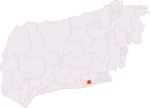Church of St Mary the Blessed Virgin, Sompting
11th-century church buildings in EnglandAdur DistrictChurch of England church buildings in West SussexGrade I listed churches in West SussexStanding Anglo-Saxon churches

The Church of St Mary the Blessed Virgin, also known as St Mary the Virgin Church and St Mary's Church, is the Church of England parish church of Sompting in the Adur district of West Sussex. It stands on a rural lane north of the urban area that now surrounds the village, and retains much 11th- and 12th-century structure. Its most important architectural feature is the Saxon tower topped by a Rhenish helm, a four-sided pyramid-style gabled cap that is uncommon in England. English Heritage lists the church at Grade I for its architecture and history.
Excerpt from the Wikipedia article Church of St Mary the Blessed Virgin, Sompting (License: CC BY-SA 3.0, Authors, Images).Church of St Mary the Blessed Virgin, Sompting
Church Lane, Adur
Geographical coordinates (GPS) Address External links Nearby Places Show on map
Geographical coordinates (GPS)
| Latitude | Longitude |
|---|---|
| N 50.8386 ° | E -0.3518 ° |
Address
Saint Mary's
Church Lane
BN15 0BA Adur
England, United Kingdom
Open on Google Maps








